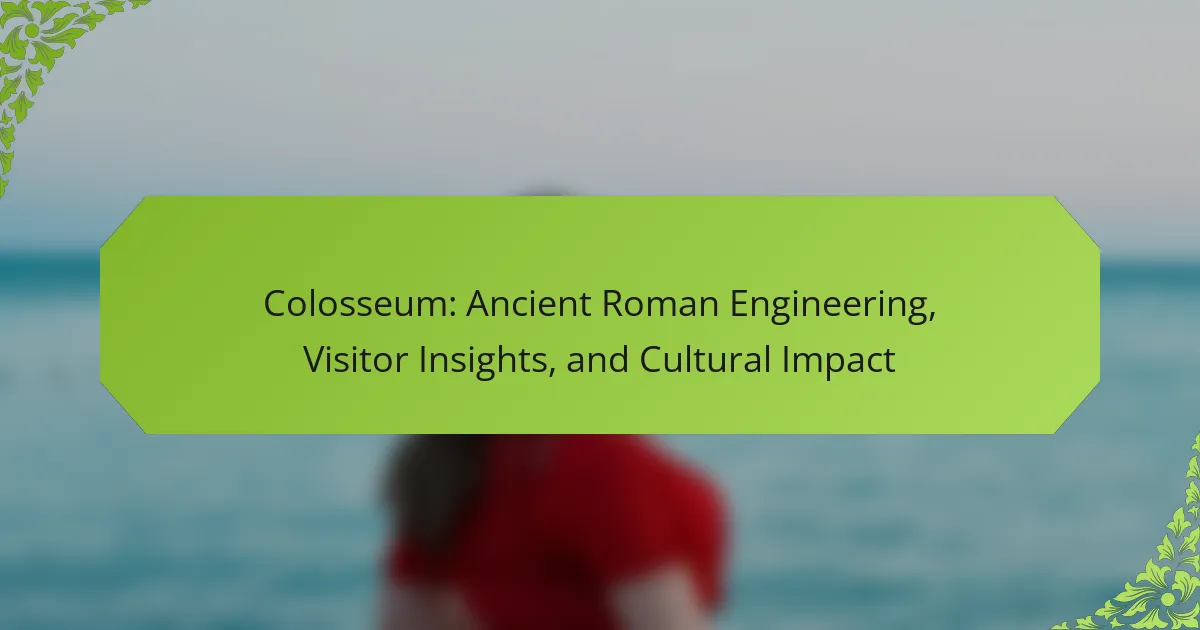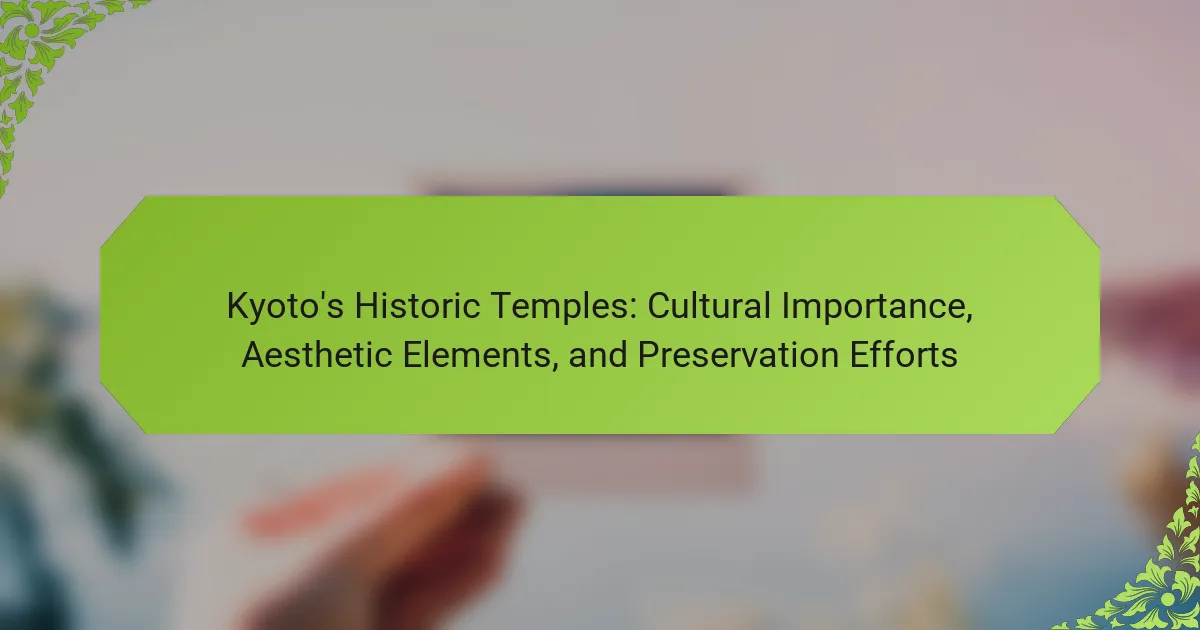The Colosseum stands as a testament to ancient Roman engineering and cultural significance. It showcases innovative construction techniques and served as a major entertainment venue. Visitors today gain insights into its historical context and architectural grandeur. Additionally, the Colosseum’s influence on modern culture and ongoing preservation efforts highlight its enduring legacy.
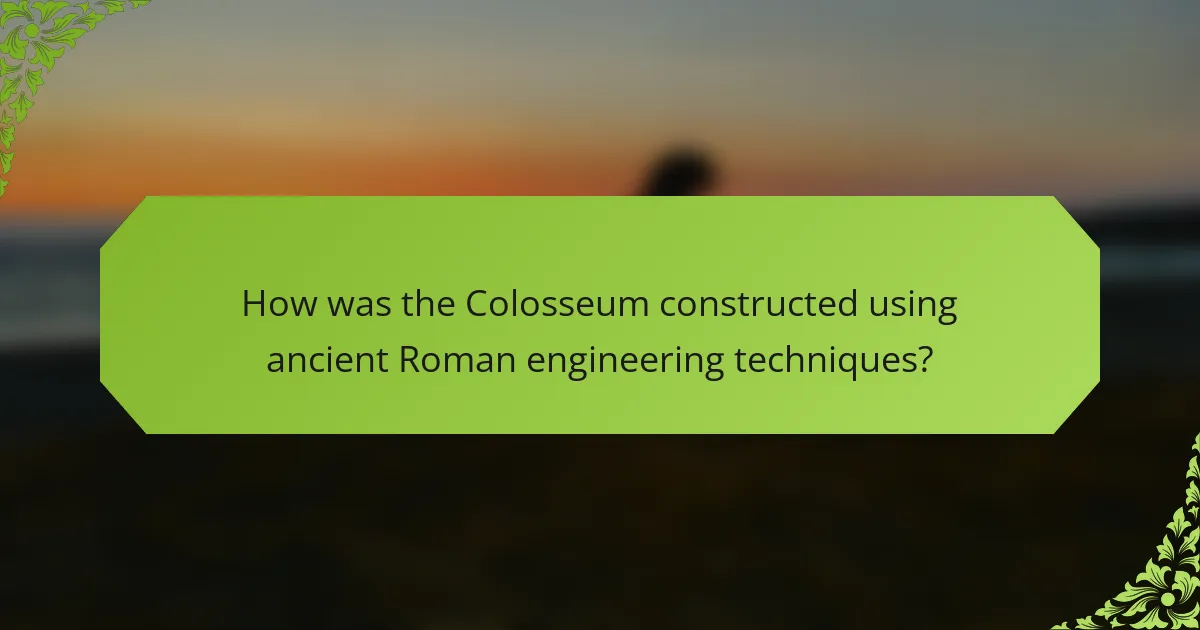
How was the Colosseum constructed using ancient Roman engineering techniques?
The Colosseum was constructed using advanced Roman engineering techniques, including concrete and the arch. Romans utilized a combination of materials like travertine, tuff, and brick, which provided structural integrity. The use of a complex system of vaults allowed for large open spaces and efficient crowd management. Approximately 100,000 cubic meters of concrete were used, showcasing their innovative approach to construction. This engineering marvel not only served as an entertainment venue but also symbolized Roman power and architectural prowess.
What materials were essential in the Colosseum’s construction?
The Colosseum’s construction relied on concrete, travertine limestone, and tuff. These materials provided strength and durability, enabling the structure to withstand time and use. Concrete, a revolutionary element, allowed for complex shapes and large spans. Travertine limestone, sourced from nearby quarries, contributed to the Colosseum’s iconic appearance. Tuff, a volcanic rock, was used in the inner walls, adding to the building’s resilience. Together, these materials exemplify ancient Roman engineering prowess.
Which architectural innovations were utilized in the Colosseum?
The Colosseum utilized several architectural innovations, including the arch, vault, and concrete. These features allowed for a large, stable structure that could accommodate thousands of spectators. The use of the Roman arch enabled the construction of expansive openings, while the vaults supported the upper levels. Concrete, a unique attribute of Roman engineering, provided strength and flexibility. Additionally, the hypogeum, an underground structure, facilitated complex staging and animal handling.
How did the Colosseum’s design contribute to its structural integrity?
The Colosseum’s design significantly enhanced its structural integrity through innovative engineering techniques. Its elliptical shape distributed weight evenly, minimizing stress on the walls. The use of arches and vaults created strong support systems, allowing for large open spaces. Additionally, the combination of concrete and stone materials contributed to durability, enabling the structure to withstand natural elements over centuries. The design principles employed reflect advanced Roman engineering, showcasing their understanding of load distribution and material properties.
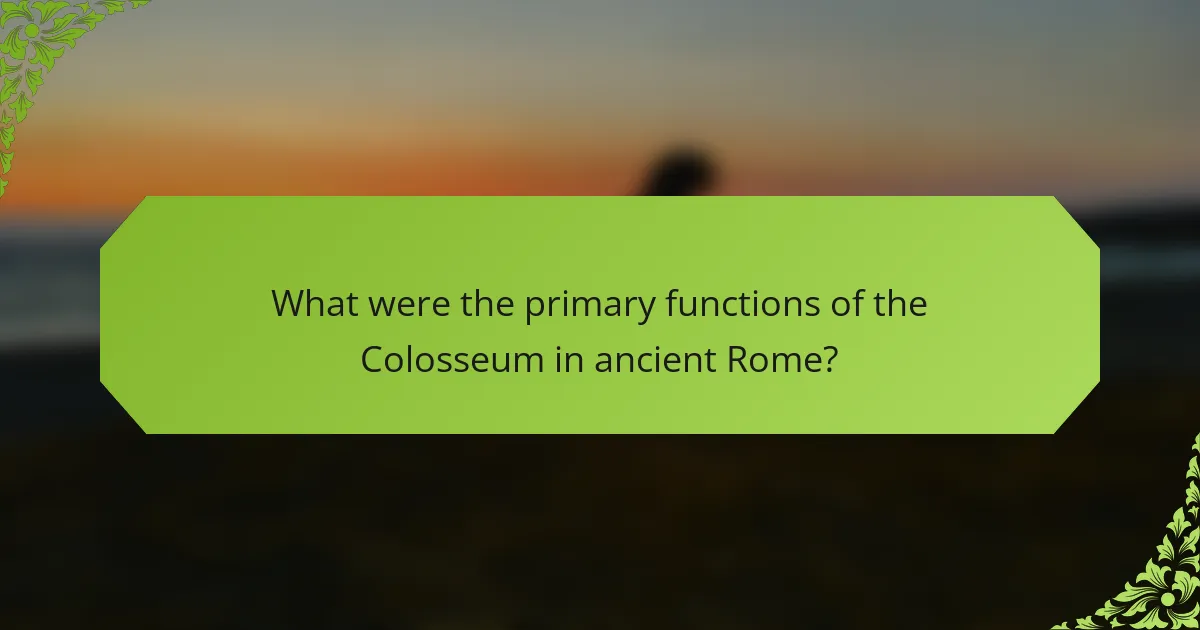
What were the primary functions of the Colosseum in ancient Rome?
The primary functions of the Colosseum in ancient Rome were to host gladiatorial contests, public spectacles, and theatrical performances. It served as a venue for entertainment, showcasing the engineering prowess of Roman architecture. The Colosseum could accommodate over 50,000 spectators, highlighting its role as a central social hub. Additionally, it symbolized Roman power and culture, reinforcing the empire’s influence and unity through grand events.
How did gladiatorial contests shape the Colosseum’s reputation?
Gladiatorial contests significantly enhanced the Colosseum’s reputation as a symbol of Roman power and entertainment. These brutal spectacles attracted massive crowds, showcasing the engineering marvel of the arena. The contests demonstrated Rome’s dominance over its enemies, reinforcing the social hierarchy and cultural values of the time. Additionally, the Colosseum became a prominent venue for public gatherings, further solidifying its status as a cultural landmark in ancient Rome.
What role did the Colosseum play in public entertainment and social gatherings?
The Colosseum served as a central hub for public entertainment and social gatherings in ancient Rome. It hosted gladiatorial games, animal hunts, and theatrical performances, attracting vast audiences. These events fostered community engagement and reflected societal values. The structure itself, with a capacity of around 50,000 spectators, facilitated social interaction across diverse classes. As a unique architectural marvel, it symbolized Roman engineering prowess and cultural identity. The Colosseum’s role in entertainment significantly influenced public life and the collective Roman experience.
Which significant events were hosted at the Colosseum?
The Colosseum hosted significant events such as gladiatorial contests, public spectacles, and mock naval battles. These events showcased Roman engineering and entertained thousands of spectators. Gladiatorial games were particularly popular, often involving combat between trained fighters. Additionally, animal hunts and executions were common, highlighting the Colosseum’s role in Roman culture. The venue could accommodate approximately 50,000 to 80,000 spectators, demonstrating its grandeur and importance in ancient Rome.
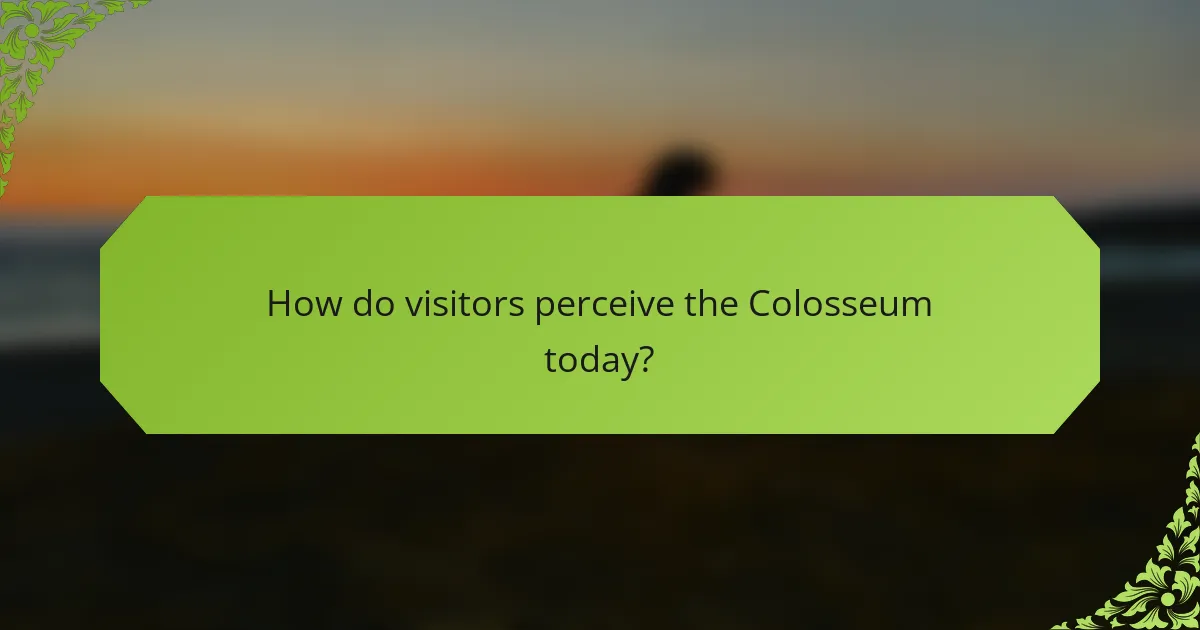
How do visitors perceive the Colosseum today?
Visitors today perceive the Colosseum as a symbol of ancient Roman ingenuity and cultural significance. Its architectural grandeur and historical context evoke admiration and curiosity. Many visitors appreciate the immersive experience of walking through the ruins, which tell stories of gladiators and public spectacles. The site’s preservation efforts enhance visitor insights, allowing them to connect with its rich past. Moreover, the Colosseum’s status as a UNESCO World Heritage site reinforces its importance in global heritage and tourism.
What are the most popular visitor experiences at the Colosseum?
The most popular visitor experiences at the Colosseum include guided tours, immersive audio-visual presentations, and access to the underground chambers. Visitors appreciate the historical reenactments that bring ancient Roman culture to life. The panoramic views from the upper tiers offer stunning cityscapes, enhancing the overall experience. Additionally, the opportunity to explore the arena floor connects guests to the Colosseum’s rich history.
How do cultural perceptions of the Colosseum vary across different countries?
Cultural perceptions of the Colosseum differ significantly across countries. In Italy, it symbolizes national pride and historical significance. In the United States, it represents ancient engineering and tourism allure. In Japan, it is viewed as a marvel of architecture and a testament to human creativity. Additionally, in countries with rich Roman history, such as Greece, it evokes nostalgia for shared heritage. These varying perspectives illustrate how the Colosseum transcends its original purpose, becoming a global icon.
What challenges do visitors face when exploring the Colosseum?
Visitors face several challenges when exploring the Colosseum, including large crowds, limited access to certain areas, and the need for advance ticket purchases. Additionally, navigating the site can be difficult due to uneven surfaces and steep stairs. Language barriers may hinder understanding of guided tours or informational signage, impacting the overall experience. Weather conditions can also affect comfort during visits, especially in summer heat or winter rain.

What impact has the Colosseum had on modern culture and society?
The Colosseum has significantly influenced modern culture and society by serving as a symbol of ancient engineering and resilience. Its architectural innovations, such as the use of arches and concrete, have inspired contemporary structures worldwide. The Colosseum represents entertainment’s evolution, impacting film, literature, and art. It also fosters tourism, attracting millions annually, which contributes to local economies. Additionally, the site promotes discussions on historical events, ethics, and the nature of public spectacles, shaping modern societal values and perspectives.
How has the Colosseum influenced contemporary architecture?
The Colosseum has significantly influenced contemporary architecture through its innovative design and structural techniques. Its use of arches, vaults, and concrete has inspired modern buildings, promoting functionality and aesthetic appeal. For instance, the incorporation of large open spaces and tiered seating in stadiums mirrors the Colosseum’s layout, enhancing spectator experience. Additionally, the Colosseum’s enduring legacy is evident in public spaces that emphasize accessibility and community engagement, reflecting its cultural impact. This ancient structure continues to serve as a reference point for architects seeking to blend historical elements with modern design principles.
What role does the Colosseum play in global tourism?
The Colosseum significantly enhances global tourism by attracting millions of visitors annually. Its architectural grandeur and historical significance draw tourists eager to explore ancient Roman culture. In 2019, it welcomed over 7.6 million visitors, making it one of the most visited monuments worldwide. The site offers immersive experiences, including guided tours and educational programs, enriching visitor insights into Roman engineering and societal structures. Additionally, the Colosseum’s cultural impact extends beyond tourism, influencing art, literature, and film, thereby reinforcing its status as a global icon.
How is the Colosseum represented in art and media?
The Colosseum is depicted in art and media as a symbol of ancient Rome’s engineering prowess and cultural significance. Various artworks, films, and literature highlight its architectural grandeur and historical narratives. Artists like Canaletto and Turner captured its beauty in paintings, while modern films often use it as a backdrop for epic scenes, emphasizing its enduring legacy. Additionally, the Colosseum appears in video games and virtual tours, enhancing visitor engagement and education about its history. This multifaceted representation showcases the Colosseum’s unique attribute as an iconic landmark, influencing both historical understanding and contemporary culture.
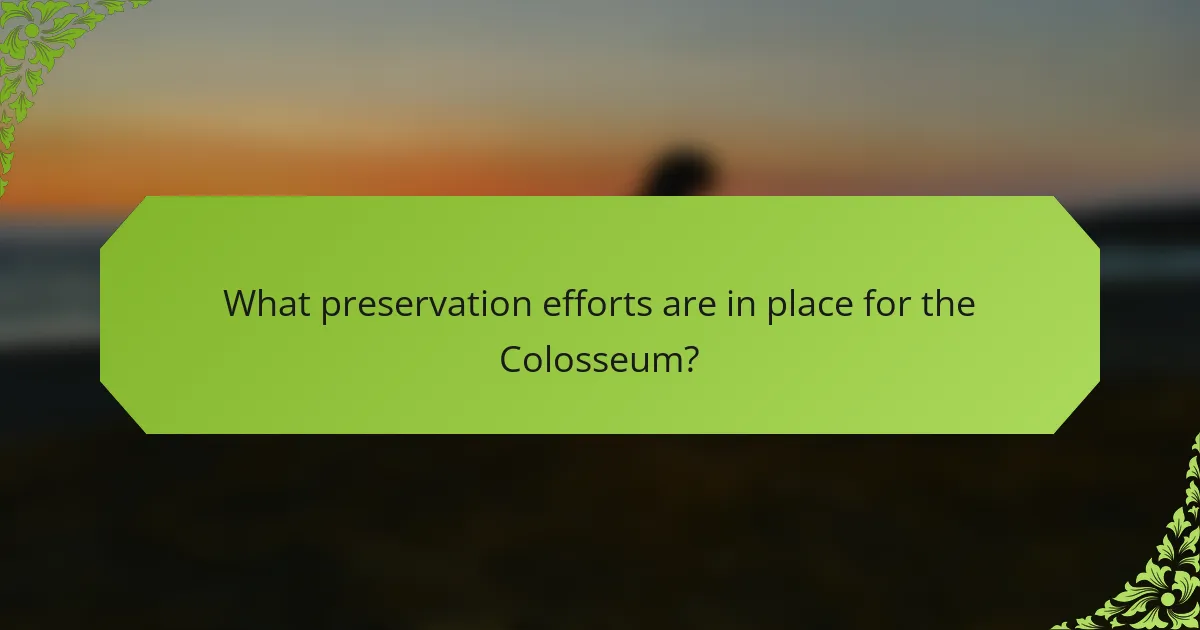
What preservation efforts are in place for the Colosseum?
Preservation efforts for the Colosseum include structural reinforcement, pollution control, and visitor management. The Italian government and cultural organizations collaborate to maintain its integrity. Recent initiatives focus on restoring ancient materials and enhancing visitor experience while minimizing impact. Regular inspections ensure ongoing safety and preservation.
Which organizations are involved in the conservation of the Colosseum?
The main organizations involved in the conservation of the Colosseum include the Italian Ministry of Cultural Heritage, the Colosseum Archaeological Park, and various international heritage organizations. Their efforts focus on preservation, restoration, and management of this iconic structure. Collaborative projects often involve funding from both public and private sectors to ensure ongoing maintenance and research. These organizations play a crucial role in protecting the Colosseum’s historical and cultural significance for future generations.
How do environmental factors affect the Colosseum’s preservation?
Environmental factors significantly impact the preservation of the Colosseum. The structure faces deterioration from pollution, weather, and seismic activity.
Pollution causes chemical reactions that weaken the stone. Rain and humidity promote erosion, while temperature fluctuations create thermal stress. Additionally, earthquakes pose a risk to its stability.
Preservation efforts must address these challenges through restoration techniques and protective measures. For instance, using breathable materials can mitigate moisture retention. Regular monitoring can help detect early signs of damage.
Overall, understanding these environmental influences is crucial for maintaining the Colosseum’s integrity and ensuring its cultural significance for future generations.
What are the challenges of maintaining the Colosseum for future generations?
Maintaining the Colosseum for future generations faces significant challenges. Key issues include structural degradation, environmental factors, and the impact of tourism.
Structural degradation stems from age and past restoration efforts that may not have used original materials. Environmental factors like pollution and weather contribute to wear and tear. The high volume of visitors can lead to further stress on the ancient structure, necessitating careful management to balance preservation with accessibility.
Funding is another challenge, as ongoing maintenance and restoration require substantial financial resources. Innovative conservation techniques must be developed to ensure the Colosseum’s integrity while accommodating modern needs.
Overall, preserving this iconic structure demands a multi-faceted approach that addresses both its historical significance and the practical realities of modern-day tourism.
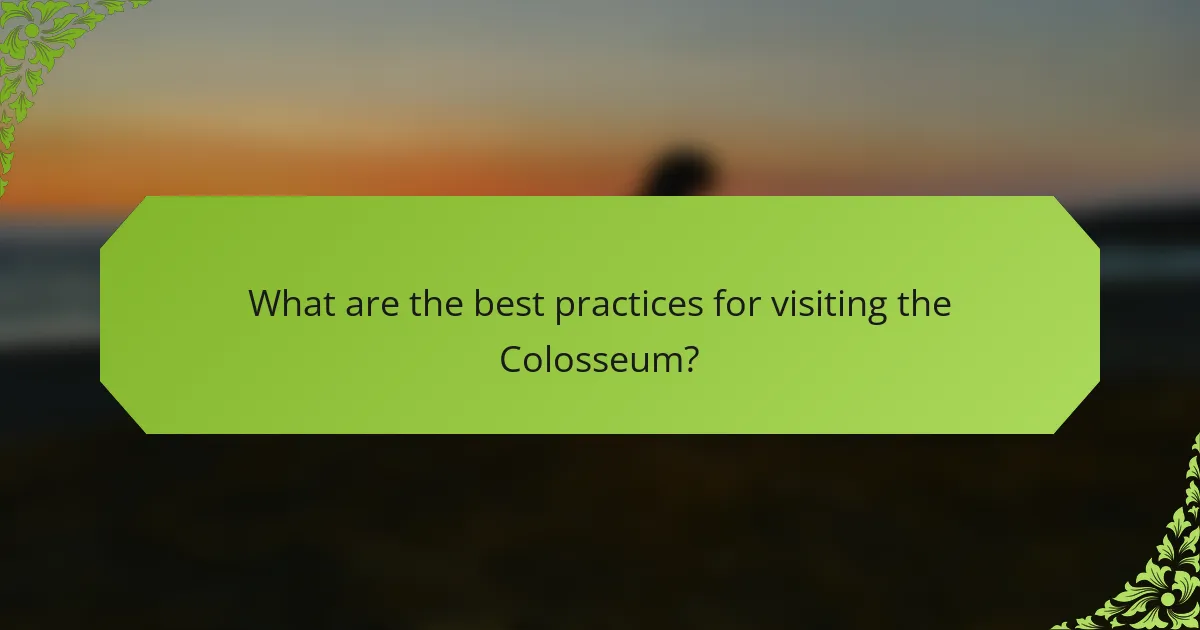
What are the best practices for visiting the Colosseum?
To enhance your visit to the Colosseum, plan ahead, arrive early, and consider guided tours. Purchasing tickets online saves time and avoids long queues. Wear comfortable shoes for extensive walking and explore nearby attractions like the Roman Forum. Stay hydrated and respect the site’s cultural significance.
How can visitors enhance their experience at the Colosseum?
Visitors can enhance their experience at the Colosseum by planning ahead and utilizing available resources. Arriving early allows for exploration without crowds. Guided tours provide in-depth historical context, enriching the visit. Using audio guides offers flexibility in pacing while ensuring key information is not missed. Engaging with interactive exhibits deepens understanding of Roman engineering and cultural significance. Lastly, visiting during off-peak hours maximizes enjoyment and accessibility.
What are common mistakes to avoid when planning a visit to the Colosseum?
To avoid common mistakes when planning a visit to the Colosseum, prioritize booking tickets in advance. Many visitors underestimate the crowds and wait times. Arriving early helps you avoid peak hours and enjoy a more immersive experience. Additionally, consider guided tours to gain deeper insights into its historical significance. Neglecting to check the weather can lead to discomfort, so plan accordingly. Lastly, ensure you understand the site’s rules regarding photography and food to enhance your visit without disruptions.
Which resources provide the best insights for first-time visitors?
The best insights for first-time visitors to the Colosseum come from official websites, guidebooks, and local tours. Official websites provide accurate historical context and visitor information. Guidebooks offer curated insights and tips for navigating the site. Local tours often include expert commentary and unique perspectives on the Colosseum’s significance.
